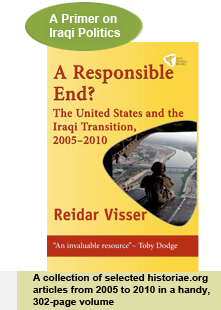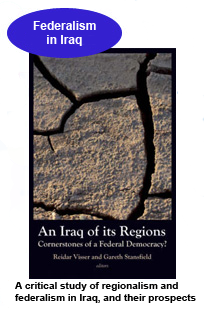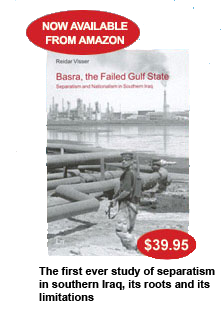



| Main | |
| Documents & images | |
| Links | |
| Contact | |
 | |
| amazon.com |

|
|
|
amazon.com
amazon.co.uk |
|

|
|
|
amazon.com
amazon.co.uk |
|
Beyond SCIRI and Abd al-Aziz al-Hakim: The Silent Forces of the United Iraqi Alliance
By Reidar Visser (http://historiae.org)
20 January 2006
[This is a postscript to an earlier article which was written on the basis of the preliminary Iraqi elections results, with special reference to the south. The distribution of seats suggested in that article is confirmed by the final count – with the last Dhi Qar seat contested by the United Iraqi Alliance (UIA) and the independent Sadrist faction 631 falling to the former (but with the vote for the Sadrists adding to their total of two compensatory “national” seats). The results thus corroborate the picture of the Supreme Council for the Islamic Revolution in Iraq (SCIRI) as being surprisingly marginal within the Alliance in terms of number of deputies from the far south. The present article explores the extent and significance of the phenomenon of SCIRI facing internal UIA challengers in the rest of the Shiite-dominated parts of Iraq. It covers the 109 UIA deputies confirmed as of 20 January 2006; the allocation of the remaining 19 “national seats” won by the UIA is expected over the coming days and will be discussed in a forthcoming note.]
With the release of final results from last December’s Iraqi elections, some reflections can be offered on the likely role of the largest winner, the United Iraqi Alliance (UIA) or list 555, in the next Iraqi parliament.
Crucial to any understanding of that role is an appreciation of the internal power games within the Alliance. One outstanding feature of the results for the “Deep South” of Iraq in the triangle Basra–Nasiriyya–Amara is the very weak representation of the party which has often been seen as the leading force within the UIA, the Supreme Council for the Islamic Revolution in Iraq (SCIRI). At first glance, this could seem like a localised phenomenon in the southernmost governorates, for the area has a strong tradition of creating internal north–south antagonisms among the Iraqi Shiites. But similar patterns, albeit slightly less pronounced, are now emerging in most areas all the way north to Salah al-Din governorate, north of Baghdad. Only the Babel governorate and the Iraqi capital have returned delegations of more than two deputies from SCIRI and its close affiliate, the Badr Organisation. The only remaining question is whether the scramble for the 19 compensatory or “national” seats won by the UIA can significantly change the balance. This is a murky process where the central coalition leaderships submit lists of candidates, and it has now emerged that the lists have yet to be handed in – thus possibly offering the SCIRI leaders a chance for reasserting themselves.
Unless SCIRI succeeds in completely dominating that final struggle, the new list of UIA deputies will warrant a rethinking of the Alliance’s prospects in Iraqi politics. No longer is it possible to maintain the traditional image of the UIA as a tool completely at the disposal of SCIRI’s Abd al-Aziz al-Hakim, with a sprinkling of wayward (but ultimately inconsequential) Sadrist renegades forming the only conceivable source of dissidence. Quite the contrary, the final results reveal vast zones of insecurity around Hakim, who himself commands the loyalty of only some 19 per cent of the Alliance’s confirmed parliamentarians. Supporters of the radical Muqtada al-Sadr, a Shiite cleric in spe who has inherited a vast number of followers from his late father (Muhammad al-Sadr, assassinated by the former regime in 1999), emerge with 25 confirmed deputies to form one of the biggest one-party delegations in the new parliament – they will probably also get additional “national” seats. They are joined by another Sadrist group, the Fadila Party, which is similarly inspired by the intellectual heritage of Muqtada’s father but which has chosen to align with an independent cleric, Muhammad al-Yaqubi. Together, as of today, they account for around 36 per cent of the UIA deputies, making it clear that the Sadrists in no way can be reduced to an ephemeral phenomenon in Iraqi politics. The second largest bloc within the Alliance identifiable by a modicum of shared political thought is also outside Hakim’s direct control: the main faction of the Daawa will be accompanied by quite a substantial group of deputies representing a Daawa breakaway entity which has added the modifier Tanzim al-Iraq (“The Iraq Organisation”) to the party name; combined they make up 23 per cent of UIA’s total of 109 confirmed deputies. A third grouping (22%), of independents and smaller parties (like Turkmen Islamists and Maysan-based Hizballah of Iraq), is less homogeneous. But they too are unlikely to act as an uncritical mass of obedient placemen for Hakim. Although they include some pro-SCIRI politicians like Abbas al-Bayati, others have backgrounds that pull in different directions – Sami al-Askari (ex-Daawa) and Husayn al-Shahristani are examples of this.

The diversity of the United Iraqi Alliance: More than 80% of its confirmed deputies belong to Sadrist or Daawa factions, or are independents. Data are for 109 UIA deputies confirmed as of 20 January 2006. An additional 19 UIA seats will be distributed as “national seats” over the coming period, based on a list to be submitted by the coalition leadership.
What are the implications of this result? Naturally, there lies a danger in over-estimating political cohesion within blocs like those made up by the various Daawa and Sadrist factions, whose experiences of internal splits have created considerable animosities between leading party personalities. It is also true that SCIRI are masterful coalition-builders whose manoeuvres have left them in control of most if not all governorate councils in the Shiite areas. And quite substantial contingents of Sadrists have in fact been sitting in the outgoing parliament for almost one year without being able to unsettle SCIRI’s hegemony. But the numerical strength of the clusters of non-SCIRI deputies will this time be more impressive. This seems bound to make some psychological impact and affect negotiating positions, and can in turn bring into play the ideological bonds that make the Sadrists and the Daawa current politically distinctive on many issues.
The most immediate decision likely to become affected by the UIA’s internal structure is the ongoing negotiations for a new coalition government. Here, the strong Sadrist and Daawa representation emphatically points towards more whole-hearted overtures towards the Sunnis, as both groups have traditionally stressed anti-sectarianism and Iraqi nationalism as key features of their programmes. (The Fadila more consistently so – grassroots elements within Muqtada al-Sadr’s movement have been involved in some ugly anti-Sunni episodes, despite their leaders’ often lofty rhetoric.) Last year, in local government in Basra, the Sadrist Fadila (together with a Daawa faction) even entered into coalition with adherents of Iyad Allawi’s secular Wifaq movement, completely sidelining none other than SCIRI in the governorate council. But whereas the Daawa current in the past has spearheaded initiatives to collaborate with more secular forces, the Sadrists have generally tended to court Islamist partners among the Sunnis – making the Sunni Islamist Iraqi Accord Front look like a particularly suitable spouse. (It is noteworthy in this regard that Islamists viewed as a bloc – i.e. all sects and ethnic groups included – total close to 180 or more than 60% of all deputies; this is more than the three fifths special majority needed to override and trump the presidency council, the transitional executive organ with a limited veto on legislation established by article 134 of the constitution and specific to the first full parliamentary period. More hypothetically, they are even within sight of the magical 183 required to form a two thirds supermajority, which is relevant in a number of legislative contexts according to the new constitution.)
Another potential impact concerns the federalism issue, expected to become important during the reassessment of the constitution scheduled for spring 2006, and a matter where simplistic media generalisations that “the Shiites all demand federalism and regional control of oil resources” are now becoming widespread. But just as the idea of a UIA perfectly submissive to Abd al-Aziz al-Hakim is overdue for revision, the notion of a homogenous “Southern Iraq” from Basra to Baghdad, united in a cry for the instant creation of a single Shiite federal entity, has now become obsolete. In the new parliament, there will be UIA representatives from the far south who, regardless of party affiliation, favour the creation of a smaller federal entity, the “Region of the South” (iqlim al-janub), limited to Basra and its two immediate neighbouring governorates. And there will be representatives dismissive of federalism altogether: the Sadrist current in particular, but also the Daawa (both factions) have historically stressed the importance of a unified Iraq and voiced scepticism towards any project involving radical decentralisation south of Baghdad, thus taking the traditional approach that sees federalism in Iraq as essentially an aspect of “the Kurdish question”. The expected Kurdish–Shiite accord (more accurately, a PUK–KDP–SCIRI deal) that would create ethnic and sectarian enclaves in Kurdish and Shiite areas and leave a barren and oil-deficient rump Iraq in the Sunni west, may therefore face competition from the original formula of a bi-national federation – in which the Arab parts of Iraq stay united, with a support base consisting of Kurds, Sunni Islamists, “northern” Sadrist and Daawa Shiite Islamists, as well as Arab secularists from all sectarian backgrounds. Or, there could be a return to one of the more constructive contributions of the 2004 Transitional Administrative Law: an upper ceiling (three) on the number of governorates allowed to amalgamate into federal entities – an arrangement originally put in place to discourage a complete surrender to the forces of ethno-sectarian politics. Kurds might support this scheme as an alternative, along with UIA and secular representatives of the far south, UIA independents, and anti-federal individuals from the other parties who could consider it the lesser of two evils. They might even be joined by defectors from SCIRI’s sectarian variant of federalism: Muwaffaq al-Rubayi, for instance, was in the past an ardent advocate of non-ethnic, “administrative” federalism.
But the federalism question cannot be studied in complete isolation – and efforts to de-emphasise ethno-religious identities will not necessarily produce solutions for other fundamental questions like the secularist–Islamist divide. A second highly charged issue is the make-up of Iraq’s constitutional court, likely to be affected by the planned one-off revision of the constitution, or by the passing of more detailed legislation during the next parliamentary session. Whereas the prerogatives of this organ are specified in the current charter, its composition is not, and the balance between secular and religious judges might easily become a bone of contention as the court could exercise veto on any legislation passed. On this issue, SCIRI has generally been reticent. But many of the non-SCIRI movements who will now fill the benches of the next parliament have shown their hands in the past: Kazim al-Hairi, the Iran-based cleric from whom at least some of the Sadrists continue to take their cues (at least some of the time), in 2004 presented a constitutional draft where he specified the balance of this court as 50–50 between religious and secular jurists (6 from each group); whereas a 2003 draft constitution by the smaller of the two Daawa factions went further, stipulating that 9 out of 15 court members be trained in Islamic legal interpretation. Both designs are reminiscent of an Iran-style guardian council and would further underline the Islamist direction of the Iraqi constitution. All this could well prove too much for the Kurds, whose acceptance of Islamist language in the Iraqi constitution has seemed conditional on the Islamic injunctions remaining empty words as far as Kurdish areas are concerned.
This shows how questions of federalism and Islamism are inextricably linked in the case of Iraq. Until now, the Kurds and SCIRI have systematically avoided confrontation over the sensitive nexus made up by those issues, preferring instead to create a paper-tiger constitution brimful of contradictions about “human rights” and Islamic law. The bubble may now burst, under the impact of (non-SCIRI) UIA deputies eager to live up to their Islamic credentials. In a worst-case scenario, this could derail any progress made on the federalism dossier in the direction of anti-sectarianism. But it could also finally make the Iraqi debate on federalism more realistic. The Kurds are unlikely ever to accept effective Islamist rule in their areas; in order to be workable, a federal design for Iraq must reflect this fact instead of sweeping the issue under the carpet through contradictory language and word games that can solve no practical problems. A more pluralistic UIA could, however unintentionally, force these key questions into the open – and perhaps thereby pave the way for institutions of central government capable of accommodating both secular and Islamic federal subunits.
With the elections results now finally released, it is tempting to speculate on how the misfit between public perceptions of the UIA and the actual patterns of party loyalties among its candidates came about in the first place. Why has the image of SCIRI as unrivalled kingmakers within the Alliance persisted, whilst some 80 per cent of coalition members hitherto confirmed as deputies have remained obscure to outsiders? Why has there been so little interest in these huge swathes of uncharted political territory? Much is probably due to the slick and professional SCIRI leadership, who have been happy to reproduce the image of their own pre-eminence within the Alliance. The US occupation authorities similarly have been content with a simplistic portrayal of the Shiite political scene: with a focus on a strong SCIRI as Washington’s partners, there have been attempts at reducing Shiite dissent to “isolated” radicals in strictly delimited geographical areas – even though the attempts during 2004 at fencing in Muqtada al-Sadr in this manner proved just as futile as the venture to define a “Sunni triangle” without acknowledging populous Mosul as constituting a vital part of it. But the pro-SCIRI bias may also be the result of a more fundamental cleft in Iraqi politics: between the leading intelligentsia, who control the media and most contact with foreign journalists, and the larger masses of impoverished Iraqis and their young leaders, who are only now beginning to assert themselves in UIA elite politics. Last November and December, for instance, often-quoted Basra intellectuals turned the biggest local newspaper into a virtual election leaflet for their political party, the Popular Democratic Association. Reading the newspaper, one might easily get the impression that this party was the major political force in the Gulf city of more than one million citizens. In the event, the party received one hundred and ninety-eight votes in Basra. (The United Iraqi Alliance got 622,121.) Imams of neighbourhood mosques may cut less impressive figures in the media world. But their impact on Iraqi politics in the early twenty-first century is formidable – and may well be a key to understanding both the provenance of the majority of votes cast on 15 December 2005, and the public enthusiasm for UIA figures who remain largely unknown outside Iraq.
Relevant links:
Helena Cobban’s blog Just World News. Features an ongoing debate about the media image and the actual strength of SCIRI, the Supreme Council for the Islamic Revolution in Iraq.
Towards Sectarian Separatism in Iraq? The sectarian federalist project in historical perspective.
Juan Cole’s blog Informed Comment. High-quality day-to-day coverage of the Iraqi transition.
Copyright © 2006 historiae.org
Statistics on deputy affiliations have been compiled from candidate lists issued by the Independent Electoral Commission of Iraq and the United Iraqi Alliance, and from local newspapers. This document may be freely reproduced as long as http://historiae.org is credited as the source.
